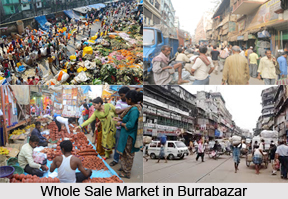 Burrabazar is now a whole sale market destination in Kolkata, developed during the British era.
Burrabazar is now a whole sale market destination in Kolkata, developed during the British era.
Location of Burrabazar
Burrabazar is located in the busiest place of Central Kolkata, before reaching Howrah Station. It is an assembly constituency. Burrabazar expanded from a yarn and textile market into the commercial nucleus of Kolkata and one of the largest wholesale markets in India.
Naming of Burrabazar
Burrabazar came from is a Hindi word meaning big market. In Bengali, it is called Barobazar, the meaning remaining same. However, there is another theory. The neighbourhood was earlier named after "Buro", the popular name of Lord Shiva or Mahadeva. The Hindi-speaking merchants who ousted the earlier local merchants, made it "Bara"
Medieval Burrabazar
In medieval era, while Jahangir"s zamindari system was in existence, this market was ruled by Seths and Basaks. This was the retail business hub in eastern region and also the manufacturing unit for Sutanati. With the arrival of the British these families flourished with renewed vigour. Janardan Sett was a trading agent of the British East India Company. Shobharam Basak became a millionaire by supplying textiles to British East India Company. One of the earliest names floating around is that of Mukundaram Sett, who lived in the earlier part of sixteenth century and moved from Satgaon or Saptagram to Gobindapur. Sutanuti haat has been traced back to 1738 by Orme. In the siege of 1756, troops of Siraj ud-daulah set fire to the market and took possession of Jorabagan and Kumortuli, neighbourhoods further north where the merchants lived.
Modern Burrabazar
Modern Burrabazar came after the decline of Nawab of Bengal and emerged as the trading centre for European good for the posh people of Kolkata and Bengal. The 16th century Sutanati haat is the Burrabazar in the 18th century till the post independence era. The market was spread over nearly 500 bighas and the residential area covered another 400 bighas. Apart from the Seths and Basaks, there were the gold merchants Mullicks and other men of their calibre. Their affluence and pomp are legends even in their days. There also were merchants of comparatively lesser affluence. The area of Kalakar Street was known as Dhakapatty, as it was home to the Sahas, cloth merchants from Dhaka. The Sheths and Basaks had close links with such cloth producing centres as Dhaka, Murshidabad (the Bengal Capital at that era) and Cossimbazar.
Geography of Burrabazar
Burrabzar is bounded by Posta and Jorabagan on the north, Jorasanko and Kolutola on the east, B. B. D. Bagh on the south and Hooghly River on the west. Lalbazar and Bowbazar are at the south-west corner of Burrabazar. The neighbourhood is adjacent to Howrah Bridge (renamed Rabindra Setu).
Structure of Burrabazar
Burrabzar has many katra or market areas. Each katra (market) is known for a particular item. There are approximately 25 katras in Burrabazar. At Raja Katra, which originally belonged to the Maharaja of Bardhaman, most of the shops deal in spices. At Manohar Das Katra it is mostly hardware and textile. Vikram Chand Market and Khangrapatti sell mostly electronic goods and artificial ornaments. For Diwali, the festival of lights, it is transformed into a huge market for festive and religious ingredients. The number of makeshift stalls is around 800, spread around Kalakar Street and other areas. From idols to their dainty dresses, designer earthen lamps to Laddus, every conceivable article can be scooped from this gala bazaar, the city"s largest assortment of puja paraphernalia. The series of shops bang opposite the Jain temple, near Satyanarayan Park, flaunts ornately decked-up idols of Lord Ganesha and Goddess Lakshmi.
Economy of Burrabzar
As Burrabzar is a market destination in Kolkata, it has a great economic value in generating revenue. Burrabazar is expanded from a yarn and textile market into one of the largest wholesale markets in India in British era. Burrabazar is divided into highly specialised sub-markets, according to the commodity it deals in - Dhotipatti, Fancypatti, Tulapatti, Chinipatti etc. Further subdivisions are katra, chowk or kothi.
Attractions in Burrabazar
As it is one of the largest shopping destination in India, Burrabazar has the number of historical buildings like Magen David Synagogue, Cathedral of the Most Holy Rosary, St Andrew"s Church, St John"s Church and Howrah Bridge which can be reached after a 15 minutes walk. Burrabazar is served by the Mahatma Gandhi Road station of Kolkata Metro.
Related Articles
Capital Cities of India
Kolkata
History of Kolkata
Culture of Kolkata
Economy of Kolkata
West Bengal, Indian State
Alipur , Kolkata
History of Alipore Zoological Gardens
Agri Horticultural Society of India
Saptagram
Agro-Horticultural Gardens
Revolutionary Terrorist Movement in India



















